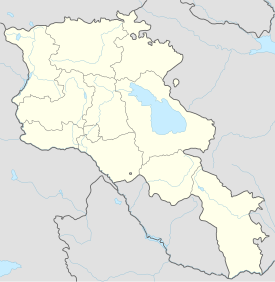| Yeghipatrush Church Եղիպատրուշ Եկեղեցի | |
|---|---|
 Yeghipatrush Church | |
| Religion | |
| Affiliation | Armenian Apostolic Church |
| Location | |
| Location | Yeghipatrush village, Aragatsotn Province, |
| Geographic coordinates | 40°32′19″N 44°28′28″E / 40.5386°N 44.4744°E |
| Architecture | |
| Style | Armenian |
| Completed | Church: 10th-13th centuries; Gavit: 12th-13th centuries |
| Dome(s) | 1 |
The Surb Astvatsatsin Church (Armenian: Եղիպատրուշ Սուրբ Աստուածածին Եկեղեցի; meaning Holy Mother of God Church); also Yeghipatrush Church (Armenian: Եղիպատրուշ Եկեղեցի) is a church located in the village of Yeghipatrush in the Aragatsotn Province of Armenia. It was constructed between the 10th and 13th centuries.
Nearby is an Early-Medieval cemetery containing the ruins of a 5th-century basilica as well as a 13th-century double-khachkar shrine.[1] Of primary interest is the 12th- to 13th-century roofless gavit, which is unique in Armenian architecture because of the inclusion of watchtowers at the plan's northeast and southeast corners. It has twelve columns in the interior. Design elements of the gavit's west portal were heavily influenced by Islamic architecture. It has a decorative archway mounted by an equilateral pointed arch, surrounded by a rectangular frame containing geometric patterns (see also Neghutsi Vank and Orbelian's Caravanserai).[2]
Architecture
The Church of S. Astvatsatsin is adjacent to the gavit and has a large cruciform central plan with a single cylindrical drum and conical dome resting above. Narrow windows with bell style arches are positioned at each of the four cardinal directions. A portal leads into the church from the west façade via the gavit.
Gallery
-
Another view of the church
-
12th- or 13th-century gavit
-
Capital in the gavit with cross carvings
-
Capital with design
-
West portal to the gavit
-
Double-khachkar shrine in nearby cemetery
References
- ^ Kiesling, Brady; Kojian, Raffi (2005). Rediscovering Armenia: Guide (2nd ed.). Yerevan: Matit Graphic Design Studio. p. 52. ISBN 99941-0-121-8.
- ^ Holding, Deirdre (2014). Armenia: with Nagorno Karabagh (Bradt Travel Guides) (4th ed.). Guilford, Conn.: The Globe Pequot Press Inc. p. 168. ISBN 978-1-84162-555-3.
Bibliography
- Kiesling, Brady (June 2000). Rediscovering Armenia: An Archaeological/Touristic Gazetteer and Map Set for the Historical Monuments of Armenia (PDF). Archived (PDF) from the original on 6 November 2021.
External links












